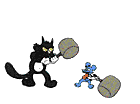Srfmowmam,
This method of using brass tongues was used some years ago by Northumbrian pipers. Brass tongues are steady (although some might think abit too "harsh" in sound) but one of the problems NSP'ers noticed was that over time the reeds develop verdigris (that green stuff you often see on brass and copper) between the tongues and the body. The only effective way to be rid of it is to strip down the reed and clean it. Then the whole process would start again. However, have you considered balsa wood bodies with brass tongues? Hobby stores sell it and it's cheap enough to experiment with.
I haven't tried it in my Uilleann pipes yet as everything is working fine and dandy. I have however completely changed the cane drone reeds in my NSP's (in all 4 drones). I used balsa bodies and metal tongues(0.02mm). A great sound and those who heard them could NOT tell the difference. I let Colin Ross in on the secret 'cos he's a great guy and he made my pipes. So my secrets out :roll: And you can bet your bottom dollar that if this gets out some folks will offer the odd snide remark about using "non traditional" material

(Adrian??).
Ah well, so what? The pipes are steady in ANY atmosphere and the tuning range of the drones is now beyond the scope of the chanter. So if my Uilleann drones start to show signs of distress I'm without doubt opting for "alternative" reed material.
Good luck with your experimentation. oh aye, thanks to John Arnold for giving me some good tips on drone reeds.
Joseph
